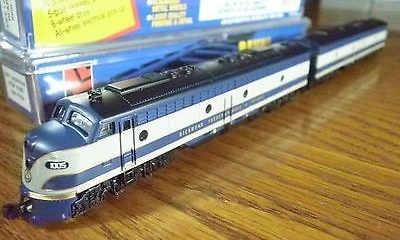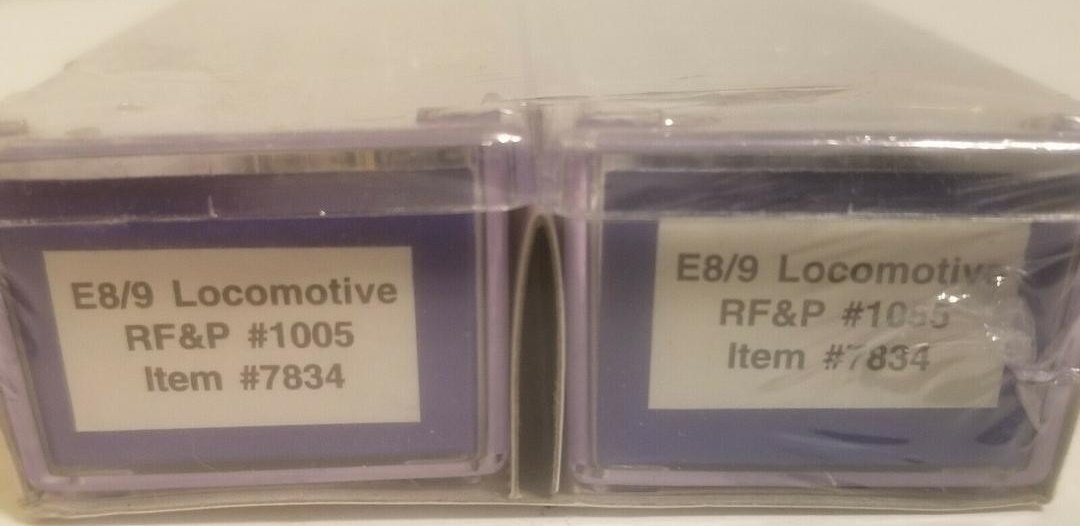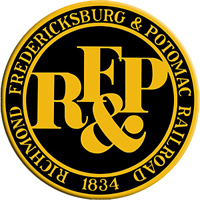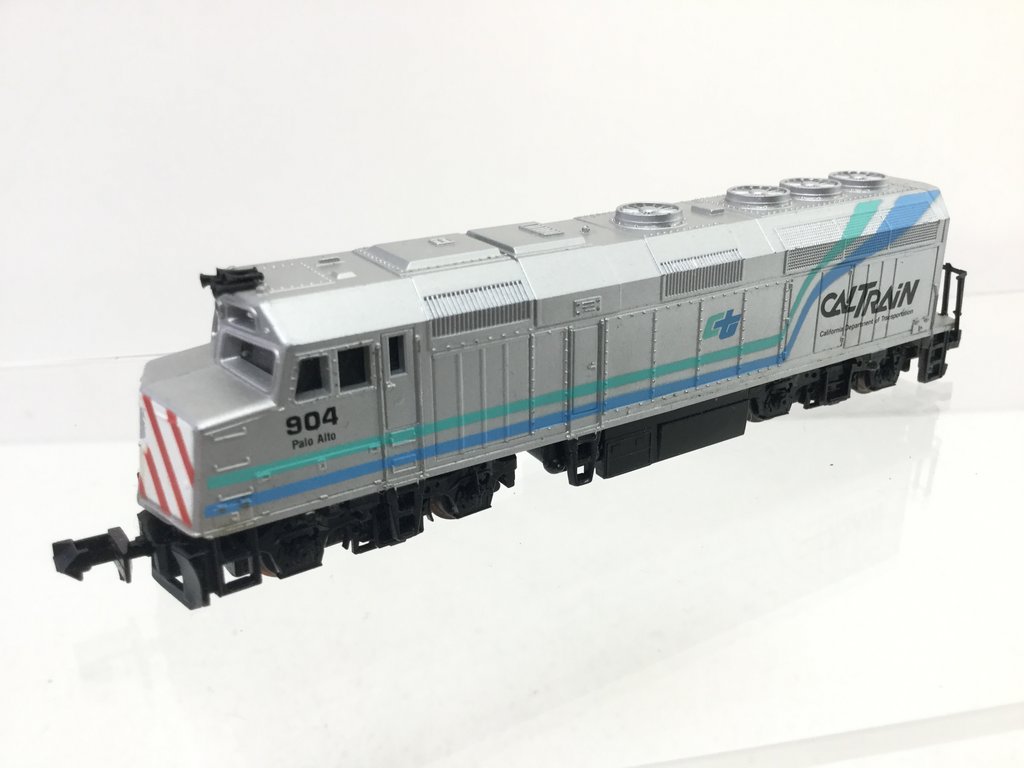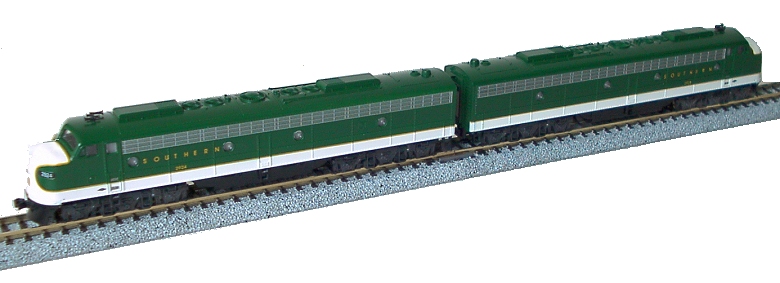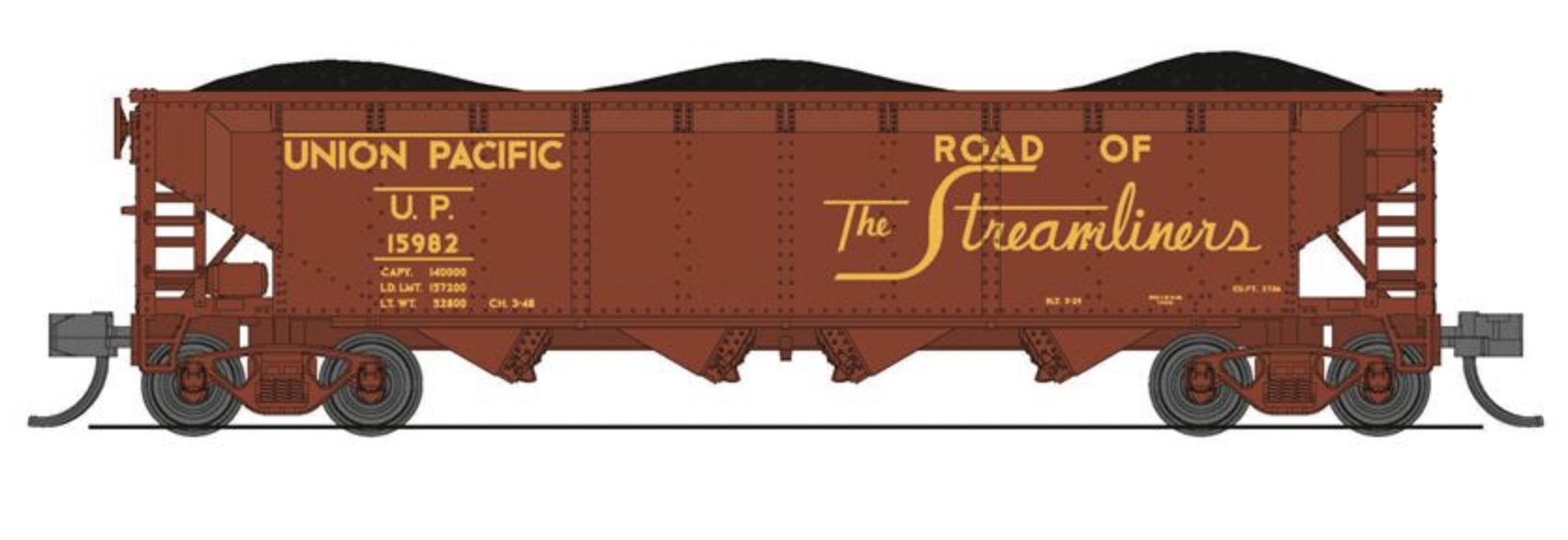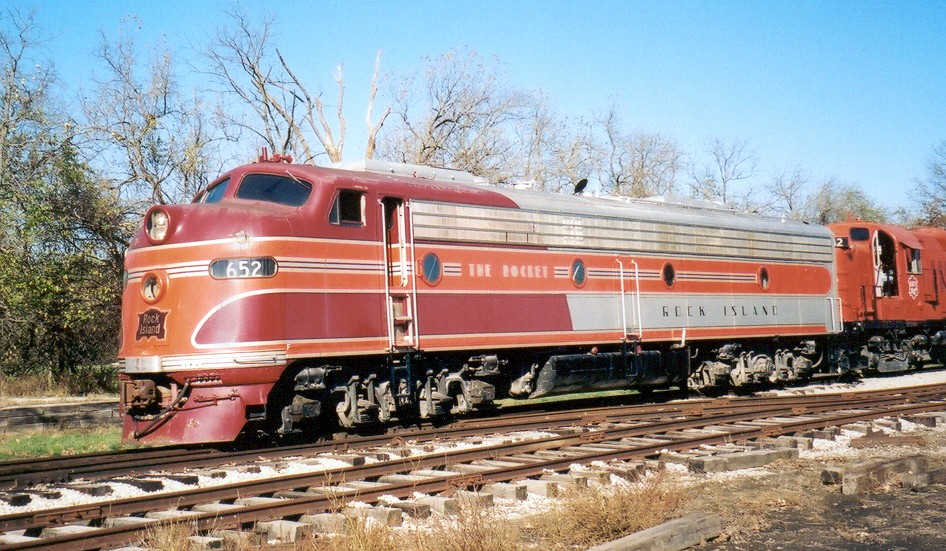Model Information: Life-Like first released this model in 1995. Dummy B units were later released in 1997.
The model was completely revised in 2003 and supplemented by a powered E8B. It was re-run again in 2006 (after Walthers acquired Life-Like); it was sold either as single A-unit or as A+B set, both powered.
Dummy body-mount knuckle coupler in front of A units. Rapido hook in rear of A units and on both sides for B units., truck-mount for the early releases, and body-mount for the 2003/2006 releases.
The model was completely revised in 2003 and supplemented by a powered E8B. It was re-run again in 2006 (after Walthers acquired Life-Like); it was sold either as single A-unit or as A+B set, both powered.
Dummy body-mount knuckle coupler in front of A units. Rapido hook in rear of A units and on both sides for B units., truck-mount for the early releases, and body-mount for the 2003/2006 releases.
DCC Information: None of the versions have support for DCC
Prototype History: The E8 was a 2,250-horsepower (1,678 kW), A1A-A1A passenger-train locomotive built by General Motors' Electro-Motive Division (EMD) of La Grange, Illinois. 450 cab versions, or E8As, were built from August 1949 to January 1954, 447 for the U.S. and 3 for Canada. 46 E8Bs were built from December 1949 to January 1954, all for the U.S. The 2,250 hp came from two 12 cylinder model 567B engines, each driving a generator to power the two traction motors on one truck. The E8 was the ninth model in the line of passenger diesels of similar design known as EMD E-units. Starting in September 1953 at total of 21 E8As were built which used either the 567BC or 567C engines.
Most of the premier passenger trains including the AT&SF "Super Chief," various CB&Q "Zephyrs," Great Northern's "Empire Builder," New York Central's "Twentieth Century" and Pennsylvania Railroad's "Broadway Limited" were pulled by EMD "E" unit diesel locomotives from the 1940's to the 1970's.
In profile the front of the nose of E7, E8, and E9 units is less slanted than earlier EMD units, and E7/8/9s (and their four axle cousins, the F-unit series) have been nicknamed bulldog nose units. Earlier E-unit locomotives were nicknamed slant nose units. After passenger trains were canceled on the Erie Lackawanna in 1970, the E8s were re-geared for freight and were very reliable for the EL. These units were on freight trains until the early years of Consolidated Railroad Corporation ("Conrail").
Units noted with the designation E8m were rebuilt using components from earlier EMC/EMD locomotives. Externally the units look just like E8s. The difference in horsepower produced in these E8m units is because the older generators are reused.
From Wikipedia
Read more on American-Rails.com
Most of the premier passenger trains including the AT&SF "Super Chief," various CB&Q "Zephyrs," Great Northern's "Empire Builder," New York Central's "Twentieth Century" and Pennsylvania Railroad's "Broadway Limited" were pulled by EMD "E" unit diesel locomotives from the 1940's to the 1970's.
In profile the front of the nose of E7, E8, and E9 units is less slanted than earlier EMD units, and E7/8/9s (and their four axle cousins, the F-unit series) have been nicknamed bulldog nose units. Earlier E-unit locomotives were nicknamed slant nose units. After passenger trains were canceled on the Erie Lackawanna in 1970, the E8s were re-geared for freight and were very reliable for the EL. These units were on freight trains until the early years of Consolidated Railroad Corporation ("Conrail").
Units noted with the designation E8m were rebuilt using components from earlier EMC/EMD locomotives. Externally the units look just like E8s. The difference in horsepower produced in these E8m units is because the older generators are reused.
From Wikipedia
Read more on American-Rails.com
Road Name History: The RF&P ran from Richmond, Virginia north 114 miles to Potomac Yard (known widely as Pot Yard) on the river near Washington D.C. The purpose of the line was to link the Pennsylvania Railroad and Baltimore & Ohio lines to the northeast with the Seaboard Air Line and Atlantic Coast Line lines to the south. There were few branchlines of consequence and the mainline was entirely double tracked with no grades to speak of. It was operated as a single route as early as 1901 although the route north of Quantico actually belonged to a PRR subsidiary called the Washington Southern. RF&P absorbed the Washington Southern in 1920. There were also connections with Southern and C&O but C&O traffic in the area was almost entirely east-west and Southern had their own line to Washington D.C.
Traffic was heavy and fast. Pacifics were used for freight and passenger service. These were supplanted by 4-8-2 Mountains then by Northerns and Berkshires. Aside from some Alco switchers, RF&P was an entirely EMD road in the diesel era. E8’s and FP7’s hauled the passengers (mostly PRR, SAL and ACL trains) while F5’s and F7’s hauled freight with GP7’s in support. The second generation brought GP35’s, and GP40’s for road service. The diesel fleet usually ran just under 40 units for the 114 mile line (indicating very heavy traffic.) As a rule, even numbered units faced north and odd numbered units faced south. Road switchers were equipped with dual cab controls and running long hood forward was common.
By 1987, RF&P’s situation had changed. The former PRR connection had mostly faded as Amtrak operated the line to the northeast and not Conrail. That left the former B&O on the north end and the former Seaboard System on the south end. Both were now part of CSX. RF&P was still a vital link but it didn’t make sense to be a separate railroad. CSX already owned much of the stock but a quarter of the shares of RF&P were owned by the state of Virginia’s state employee retirement fund. In the end, CSX gave the state fund the property rights to Potomac Yard in exchange for all of the stock. Pot Yard originated or terminated very little traffic with nearly every train just running through so the property was ripe for development. In fact there was talk of turning part of the property into a new stadium for the Washington Redskins. In the end, it became commercial property instead. The state was happy and CSX closed the gap on their system map. RF&P merged into CSX in 1991.
Traffic was heavy and fast. Pacifics were used for freight and passenger service. These were supplanted by 4-8-2 Mountains then by Northerns and Berkshires. Aside from some Alco switchers, RF&P was an entirely EMD road in the diesel era. E8’s and FP7’s hauled the passengers (mostly PRR, SAL and ACL trains) while F5’s and F7’s hauled freight with GP7’s in support. The second generation brought GP35’s, and GP40’s for road service. The diesel fleet usually ran just under 40 units for the 114 mile line (indicating very heavy traffic.) As a rule, even numbered units faced north and odd numbered units faced south. Road switchers were equipped with dual cab controls and running long hood forward was common.
By 1987, RF&P’s situation had changed. The former PRR connection had mostly faded as Amtrak operated the line to the northeast and not Conrail. That left the former B&O on the north end and the former Seaboard System on the south end. Both were now part of CSX. RF&P was still a vital link but it didn’t make sense to be a separate railroad. CSX already owned much of the stock but a quarter of the shares of RF&P were owned by the state of Virginia’s state employee retirement fund. In the end, CSX gave the state fund the property rights to Potomac Yard in exchange for all of the stock. Pot Yard originated or terminated very little traffic with nearly every train just running through so the property was ripe for development. In fact there was talk of turning part of the property into a new stadium for the Washington Redskins. In the end, it became commercial property instead. The state was happy and CSX closed the gap on their system map. RF&P merged into CSX in 1991.
Brand/Importer Information:  Life-Like Products LLC (now Life-Like Toy and Hobby division of Wm. K. Walthers) was a manufacturer of model railroad products and was based in Baltimore, Maryland.
Life-Like Products LLC (now Life-Like Toy and Hobby division of Wm. K. Walthers) was a manufacturer of model railroad products and was based in Baltimore, Maryland.
It was founded in the 1950s by a company that pioneered extruded foam ice chests under the Lifoam trademark. Because ice chests are a summer seasonal item, the company needed a way to keep the factory operating year round. As model railroading was becoming popular in the post-war years, they saw this as an opportunity and so manufactured extruded foam tunnels for model trains. Over the years, Life-Like expanded into other scenery items, finally manufacturing rolling stock beginning in the late 1960s. At some point in the early 1970s, Life-Like purchased Varney Inc. and began to produce the former Varney line as its own.
The Canadian distributor for Life-Like products, Canadian Hobbycraft, saw a missing segment in market for Canadian model prototypes, and started producing a few Canadian models that were later, with a few modifications, offered in the US market with US roadnames.
In 2005, the company, now known as Lifoam Industries, LLC, decided to concentrate on their core products of extruded foam and sold their model railroad operations to Wm. K. Walthers.
In June 2018, Atlas and Walthers announced to have reached an agreement under which all Walthers N scale rolling stock tooling, including the former Life-Like tooling, will be purchased by Atlas.
Read more on Wikipedia and The Train Collectors Association.

It was founded in the 1950s by a company that pioneered extruded foam ice chests under the Lifoam trademark. Because ice chests are a summer seasonal item, the company needed a way to keep the factory operating year round. As model railroading was becoming popular in the post-war years, they saw this as an opportunity and so manufactured extruded foam tunnels for model trains. Over the years, Life-Like expanded into other scenery items, finally manufacturing rolling stock beginning in the late 1960s. At some point in the early 1970s, Life-Like purchased Varney Inc. and began to produce the former Varney line as its own.
The Canadian distributor for Life-Like products, Canadian Hobbycraft, saw a missing segment in market for Canadian model prototypes, and started producing a few Canadian models that were later, with a few modifications, offered in the US market with US roadnames.
In 2005, the company, now known as Lifoam Industries, LLC, decided to concentrate on their core products of extruded foam and sold their model railroad operations to Wm. K. Walthers.
In June 2018, Atlas and Walthers announced to have reached an agreement under which all Walthers N scale rolling stock tooling, including the former Life-Like tooling, will be purchased by Atlas.
Read more on Wikipedia and The Train Collectors Association.
Item created by: Alain LM on 2021-09-12 12:42:45
If you see errors or missing data in this entry, please feel free to log in and edit it. Anyone with a Gmail account can log in instantly.
If you see errors or missing data in this entry, please feel free to log in and edit it. Anyone with a Gmail account can log in instantly.


